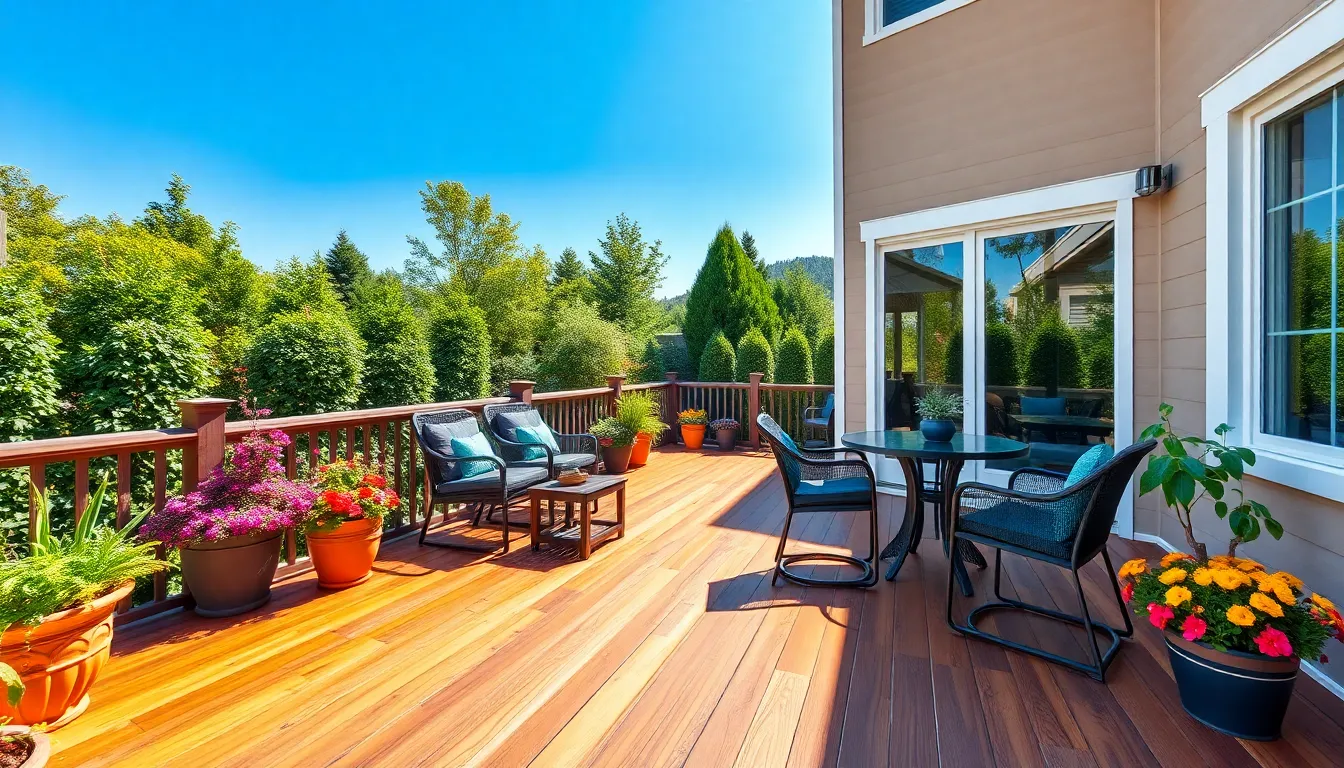Vinyl decking is quickly becoming a popular choice for homeowners seeking a stylish and durable outdoor space. Unlike traditional wood decking, vinyl offers a range of benefits that make it an attractive option for those looking to enhance their patios or balconies. With its resistance to moisture, mold, and fading, vinyl decking promises longevity while maintaining its aesthetic appeal.
In addition to its practical advantages, vinyl decking comes in various colors and textures, allowing homeowners to customize their outdoor areas to fit their unique style. As more people prioritize low-maintenance solutions, understanding the features and benefits of vinyl decking can help make informed decisions for any outdoor renovation project.
Table of Contents
ToggleWhat Is Vinyl Decking?
Vinyl decking refers to a synthetic material made primarily from polyvinyl chloride (PVC). It serves as an alternative to traditional wood and composite decking. Vinyl decking combines high durability with low maintenance, making it an attractive choice for outdoor spaces.
Vinyl decking features a waterproof surface that resists moisture damage, mold growth, and fading from UV exposure. This resistance contributes to a longer lifespan compared to wood materials. Homeowners can enjoy a variety of colors, textures, and finishes, allowing for customization that complements any outdoor aesthetic.
Installation of vinyl decking involves a straightforward process, often requiring less time than wood alternatives. The lightweight nature of vinyl simplifies transportation and handling during installation. Many vinyl decking options come with interlocking systems that enhance stability and ease of assembly.
Vinyl decking delivers an eco-friendly option as well, with many manufacturers offering products made from recycled materials. This aspect appeals to environmentally conscious consumers seeking sustainable building solutions. Overall, vinyl decking provides a modern approach to outdoor living spaces while prioritizing durability and style.
Advantages of Vinyl Decking

Vinyl decking presents numerous advantages for homeowners seeking a durable and attractive outdoor space. Its unique properties and benefits set it apart from traditional decking options.
Durability and Longevity
Vinyl decking delivers exceptional durability, featuring a design that resists cracking, warping, and splintering. It withstands harsh weather conditions, including extreme heat and cold, without compromising its structural integrity. With a lifespan exceeding 25 years, it offers reliable performance over time, making it a cost-effective investment for outdoor areas.
Low Maintenance Requirements
Vinyl decking simplifies outdoor maintenance, requiring minimal effort to keep it in pristine condition. Regular cleaning involves only soap, water, and a soft brush. Unlike wood, vinyl doesn’t necessitate sanding, staining, or sealing, saving homeowners both time and expense. This low-maintenance feature aligns with the needs of busy lifestyles, allowing more time for enjoyment rather than upkeep.
Aesthetic Appeal
Vinyl decking features an array of colors, textures, and patterns, providing design versatility for any outdoor style. It mimics the look of natural wood while offering added benefits, such as fade resistance and easier cleaning. This aesthetic flexibility allows homeowners to create a personalized outdoor space that enhances the overall appeal of their property.
Disadvantages of Vinyl Decking
Despite its advantages, vinyl decking presents several drawbacks that potential buyers should consider.
Cost Considerations
Vinyl decking often carries a higher initial cost compared to traditional wood options. Prices typically range from $3 to $10 per square foot, depending on the quality and brand. While the longer lifespan may offset this investment over time, homeowners must be prepared for a significant upfront expenditure. Additional costs, such as professional installation or specialized maintenance tools, can further contribute to the overall financial burden.
Temperature Sensitivity
Vinyl decking can be sensitive to extreme temperature fluctuations. In direct sunlight, the surface may heat up significantly, reaching uncomfortable levels for bare feet. This temperature increase can also lead to expansion and contraction, potentially causing issues like warping or buckling over time. Homeowners in regions with intense heat should consider shade options to mitigate these effects.
Installation Process
Installing vinyl decking requires careful preparation and the right tools. This section outlines the steps involved in transforming an outdoor space with durable and stylish vinyl decking.
Preparation and Planning
Preparing for vinyl decking installation involves several key steps. First, homeowners should measure the area accurately to determine the amount of material needed. Next, it’s essential to assess the existing surface for damage and ensure it’s level and clean. Clearing the area and removing any old decking or debris sets the foundation for a successful installation. Planning the layout also includes deciding on the direction of the boards for optimal aesthetics and drainage. Finally, reviewing local building codes can prevent potential issues down the line.
Tools and Materials Needed
Essential tools and materials streamline the installation process. The following list includes the necessary items:
- Vinyl decking boards: Choose boards that meet specific size and color preferences.
- Fasteners: Use appropriate stainless steel or corrosion-resistant screws.
- Circular saw: Ensure sharp blades for clean cuts.
- Drill: Allows precise fastening and hole drilling.
- Measuring tape: Essential for accurate measurements.
- Level: Ensures even installation.
- Safety goggles and gloves: Protect personal safety during installation.
Having these tools ready beforehand reduces delays during the installation process.
Step-by-Step Installation Guide
The installation process can be broken down into clear steps:
- Install a substructure: Begin with a strong framework using pressure-treated wood or aluminum. Ensure the substructure is level and adequately spaced.
- Lay down the deck boards: Position the first vinyl board at one end of the structure, ensuring it aligns with the edge. Leave space for expansion.
- Attach the boards: Fasten the boards using the specified screws. Position screws at intervals recommended by the manufacturer, typically 16 inches apart, ensuring it’s secure.
- Continue laying boards: Repeat the process for the remaining boards, ensuring proper alignment and spacing.
- Cut as needed: Use a circular saw to create custom cuts for edges and corners, ensuring a neat finish.
- Add trim pieces: Install any required trim around the edges for a polished appearance.
- Inspect the installation: Check for any loose areas or imperfections and make adjustments as necessary.
Following these steps ensures a smooth and efficient vinyl decking installation, creating a beautiful outdoor space ready for enjoyment.
Maintenance Tips
Maintaining vinyl decking ensures its longevity and aesthetic appeal. Regular attention keeps surfaces clean and damage-free.
Cleaning and Care
Cleaning vinyl decking requires minimal effort. Use a mixture of soap and water along with a soft brush to eliminate dirt and debris. For stubborn stains, a non-abrasive cleaner may assist in lifting the marks without harming the surface. It’s advisable to rinse the deck with clean water after washing to remove any cleaning residue. Regular cleaning every few months helps maintain its appearance and protects against dirt build-up.
Repairing Damage
Repairing minor damage on vinyl decking is straightforward. For scratches and scuffs, a vinyl repair kit can assist in restoring the surface. These kits typically include filler material and color-matching components. For deeper cuts or significant damage, replacing a single board may be necessary. Ensure to choose the same color and texture for a seamless look. Promptly addressing any damage minimizes the risk of further deterioration and maintains the deck’s integrity.
Vinyl decking stands out as a premier choice for homeowners aiming to enhance their outdoor spaces. Its blend of durability and low maintenance makes it an attractive option for those who value both aesthetics and practicality. With a variety of styles available, homeowners can easily find a design that complements their property’s character.
While the initial investment may be higher than traditional wood, the long-lasting benefits and reduced upkeep can make vinyl decking a wise financial decision. As outdoor living continues to gain popularity, embracing vinyl decking can transform any patio or deck into a stylish and functional area for relaxation and entertainment.


